Luxury Stores in China Are Making Moves on WeChat
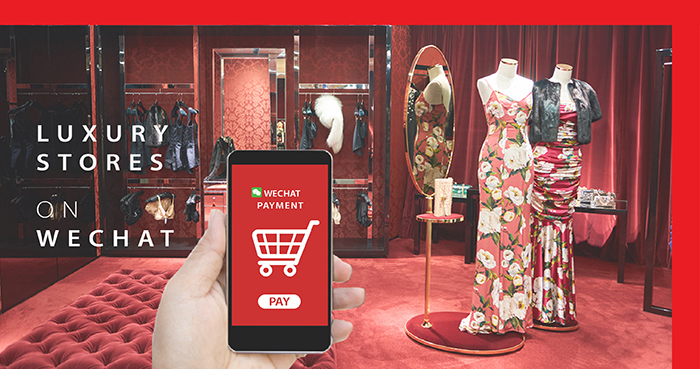
While 2017 promises to be a better year than 2016 for the luxury market in China, the fierce competition for sales has not let up.
To increase outreach to their customers, many brands are investing heavily into e-commerce channels. About 92 percent of top luxury brands in China now have an account on the messaging app WeChat, compared to only about half that in 2014. This puts WeChat on par with Weibo, a popular Chinese microblogging site, on which about 94 percent of luxury brands have an account.
WeChat and the WeChat Store allow brands to stage creative and engaging marketing campaigns to reach customers in China. Setting up shops and multimedia marketing on the app has become simpler, as Tencent – WeChat’s developer – courts luxury brands in its competition with Chinese e-commerce giant Alibaba. For the most part, the move has been successful with more luxury brands experimenting with the app.
However, the road is not without its own perils; the logistics of luxury e-commerce can be difficult and counterfeiting remains problematic. This article looks at how WeChat can be used to engage Chinese consumers, and how luxury brands have used the app’s functions to stage creative marketing campaigns.
![]() RELATED: Closing Shop on China’s e-Commerce Platforms: Why Are Big Name Brands Leaving Tmall?
RELATED: Closing Shop on China’s e-Commerce Platforms: Why Are Big Name Brands Leaving Tmall?
What is WeChat?
WeChat is one of the most widely used apps in China. While those outside of the mainland may use different apps for messaging, reading news, catching up on social media, ordering food, buying tickets, making appointments and more, those in China can do everything on WeChat, meaning a user never has to leave the app.
Called Weixin in Chinese, the app had 768 million daily logged-in users by September 2016, and a year-on-year growth of 35 percent. In Q1 2017, monthly active users reached 938 million.
The app also allows users to send money linked to bank accounts through WeChat money transfers, or through “red packets”, which depict the red envelopes that are traditionally gifted on special occasions. In 2016, the average user sent over 70 messages per day and 28 “red packets” per month, spending RMB 580 per month.
Another feature of WeChat, and the main attraction for luxury brands, is the WeChat store – a digital store connected to the company’s official WeChat account. All WeChat users can access the website and can pay for the store’s products through WeChat Pay. WeChat stores can be created independently, or through third party e-commerce platforms, a process that is quicker and cheaper than Alibaba’s B2C e-commerce platform Taobao.
How luxury brands use WeChat
It is through these WeChat stores that many luxury brands are now targeting their customers, and it is easy to see why. By opening a WeChat store, companies can receive orders in real time, spread sales promotions through coupons and WeChat group buying, access analytics to track growth, and customize the page to fit brand image.
Moreover, WeChat has the ability to flexibly switch from “one to many” communication through public posts and moments to “one to one” in the official account page where users can directly chat with the brand. This gives companies the ability to segment their database and tailor push messages. This also means that brands have to understand their WeChat customer base, and how to most effectively market towards them.
Luxury brands are continuing to experiment with WeChat and its different features, and this is apparent in the different campaigns that several top brands have pursued.
Burberry, one of the early adopters, has seen some success with a series of WeChat marketing campaigns, including “the Scarf Bar” and its interactive “Heritage Trench Coat” campaign, in which WeChat followers had a 360-degree viewing of the 2014 fashion show put on during the opening of Burberry’s fourth flagship store in Shanghai.
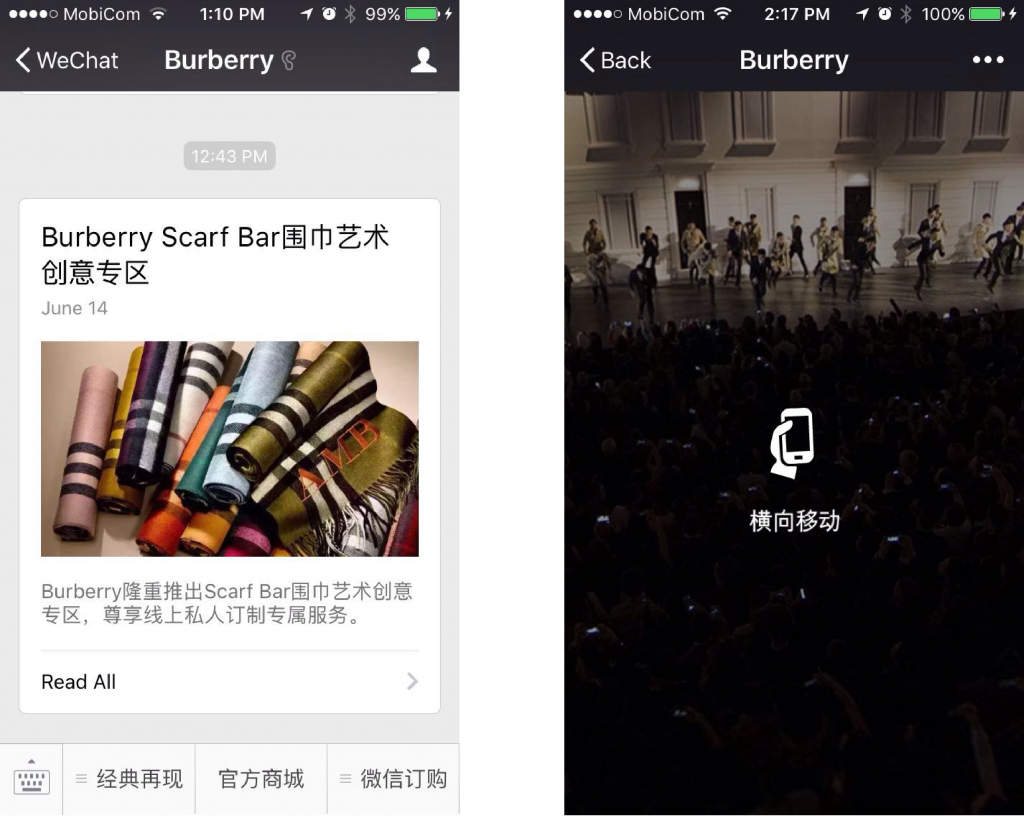
Longchamp, another early adopter, created a related mini program where users can personalize their bags before ordering. Followers enter the mini program under a separate category on Longchamp’s official WeChat page, choose the color and badges of their desired Le Pliage handbag, input order information, and directly pay through WeChat.
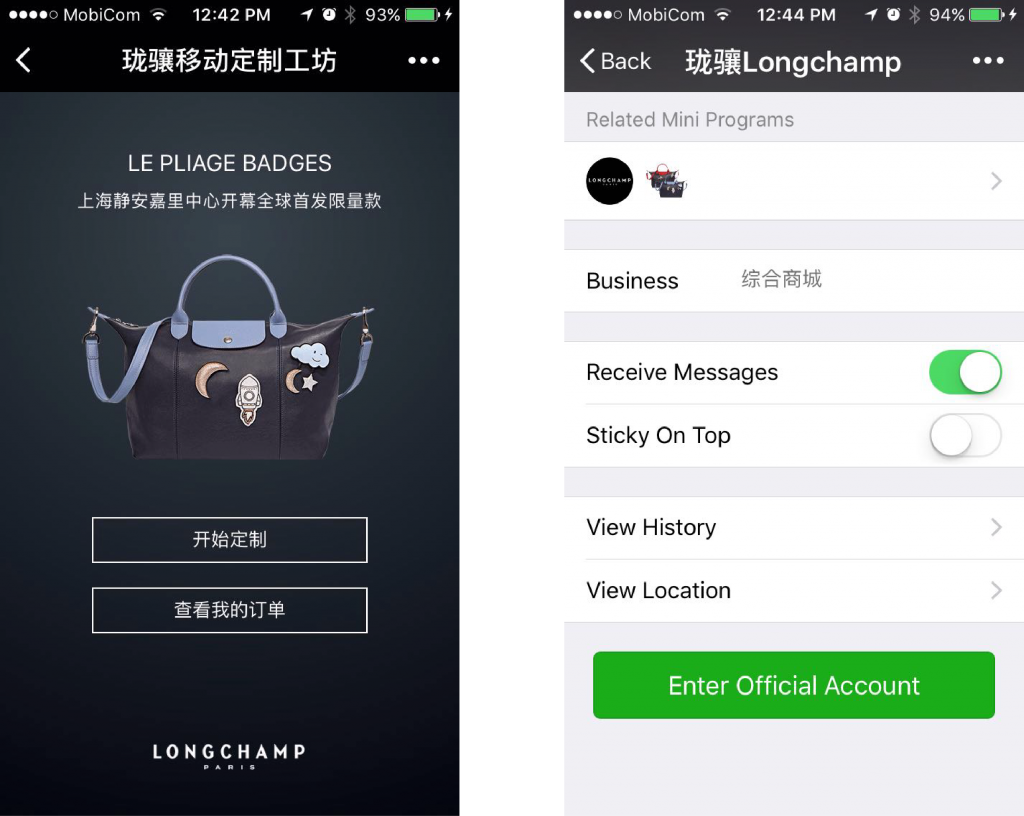
Chanel advertises heavily through WeChat Moments, a function similar to Facebook’s timeline that allows users to share pictures, statuses, and links with followers and friends. Chanel particularly likes to publish ad campaigns that include large, high resolution photos with short videos and links to its online store.
![]() RELATED: Business Intelligence Solutions from Dezan Shira & Associates
RELATED: Business Intelligence Solutions from Dezan Shira & Associates
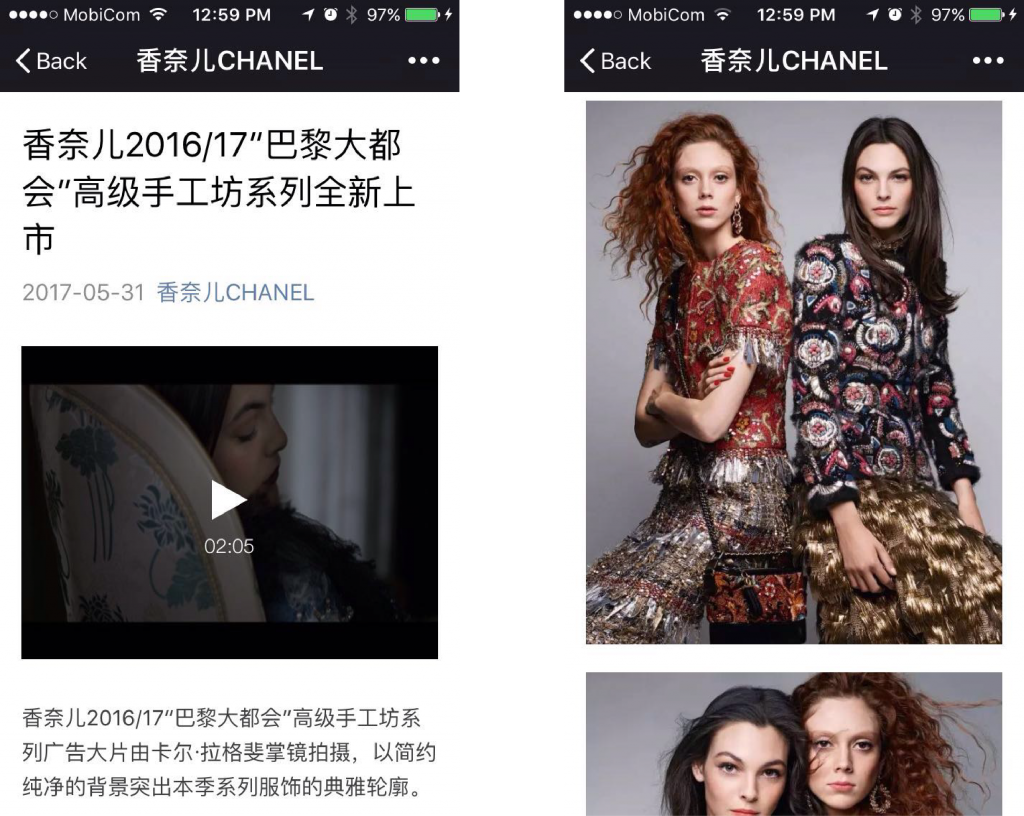
Many luxury brands have also worked with domestic celebrities in their WeChat ad campaigns, often including videos and interviews in addition to text content. In March 2017, Bulgari ran a campaign with Kris Wu, a popular Chinese singer and actor, detailing the two days Wu spent attending the Baselworld Show. The post included photos, gifs, and videos, and ended with call to pre-order the Octo Finissimo Automatic Watch.
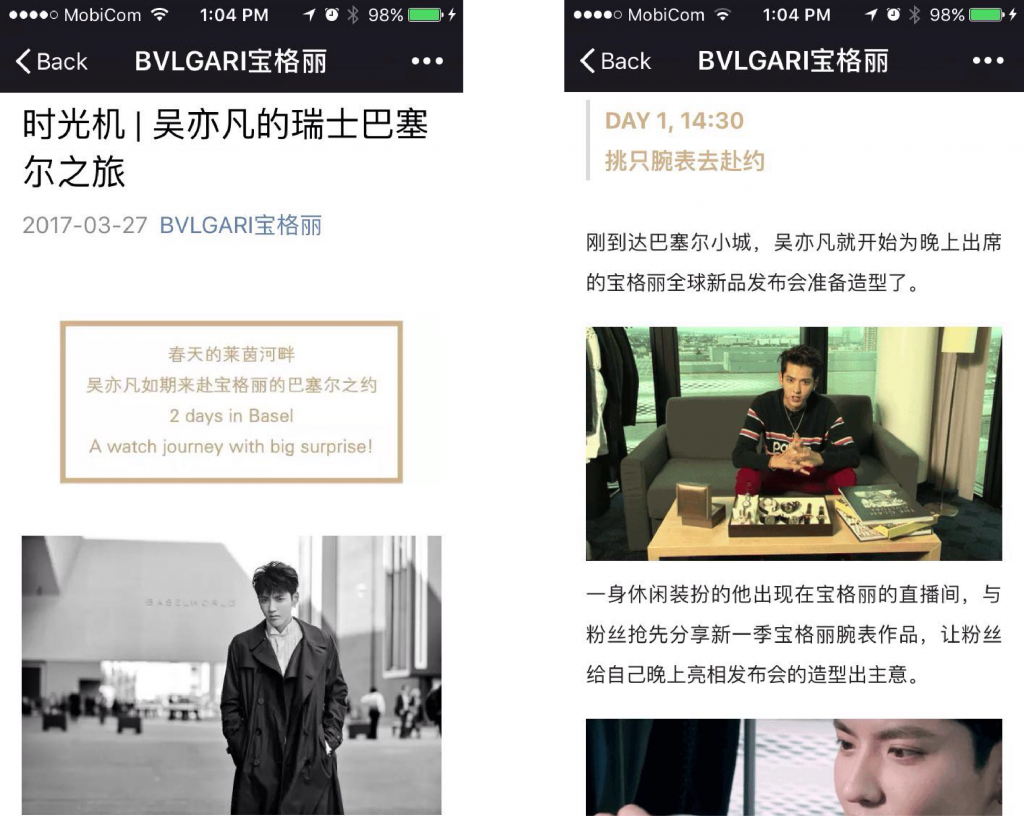
Digital innovation: key to winning the luxury game
Despite all its advantages, WeChat has obvious risks for luxury brands.
First of all, the nature of luxury does not always comply neatly with WeChat’s features. Many brands worry about maintaining image and reputation, and for good reason. After all, WeChat is a free application and available to anyone who downloads it; furthermore, brands have to comply with available templates. These are additional challenges for luxury companies, who have to optimize their WeChat accounts and create not only mobile, but also WeChat-friendly content to maintain brand image.
Secondly, the logistics of luxury e-commerce can be difficult to navigate. Shipping an RMB 10,000 (US$1,471) bag via delivery can result in expensive mistakes and angry customers. This can be a case where brands push for online to offline (O2O) experiences to have in-shop pick-ups, or develop closer relationships with trustworthy delivery services.
Finally, online counterfeit sales continue to be a problem for luxury brands in China despite efforts to curtail them.
WeChat offers an accessible platform for brands to penetrate the Chinese market and tailor their advertising to consumers, but like all new sales channels, there is a steep learning curve and a good amount of risk. However, with the race to capture sales and customers, brands who do not embrace innovation will be left behind.
|
China Briefing is published by Asia Briefing, a subsidiary of Dezan Shira & Associates. We produce material for foreign investors throughout Asia, including ASEAN, India, Indonesia, Russia, the Silk Road, and Vietnam. For editorial matters please contact us here, and for a complimentary subscription to our products, please click here. Dezan Shira & Associates is a full service practice in China, providing business intelligence, due diligence, legal, tax, IT, HR, payroll, and advisory services throughout the China and Asian region. For assistance with China business issues or investments into China, please contact us at china@dezshira.com or visit us at www.dezshira.com
|

Dezan Shira & Associates Brochure
Dezan Shira & Associates is a pan-Asia, multi-disciplinary professional services firm, providing legal, tax and operational advisory to international corporate investors. Operational throughout China, ASEAN and India, our mission is to guide foreign companies through Asia’s complex regulatory environment and assist them with all aspects of establishing, maintaining and growing their business operations in the region. This brochure provides an overview of the services and expertise Dezan Shira & Associates can provide.
An Introduction to Doing Business in China 2017
This Dezan Shira & Associates 2017 China guide provides a comprehensive background and details of all aspects of setting up and operating an American business in China, including due diligence and compliance issues, IP protection, corporate establishment options, calculating tax liabilities, as well as discussing on-going operational issues such as managing bookkeeping, accounts, banking, HR, Payroll, annual license renewals, audit, FCPA compliance and consolidation with US standards and Head Office reporting.
Payroll Processing in China: Challenges and Solutions
In this issue of China Briefing magazine, we lay out the challenges presented by China’s payroll landscape, including its peculiar Dang An and Hu Kou systems. We then explore how companies of all sizes are leveraging IT-enabled solutions to meet their HR and payroll needs, and why outsourcing payroll is the answer for certain company structures. Finally, we consider the potential for China to emerge as Asia’s premier payroll processing center.
- Previous Article Xi Offers Free Trade to Shanghai Cooperation Organization Members
- Next Article China’s New Cybersecurity Law: Clarifications, Implementation Delay Announced












